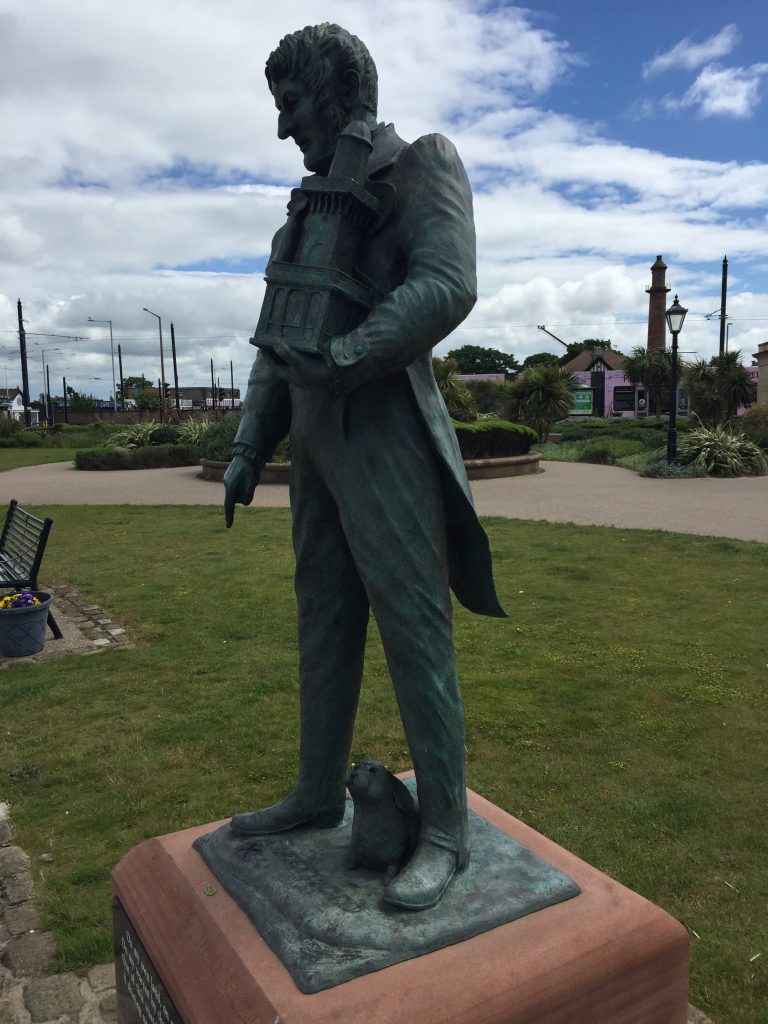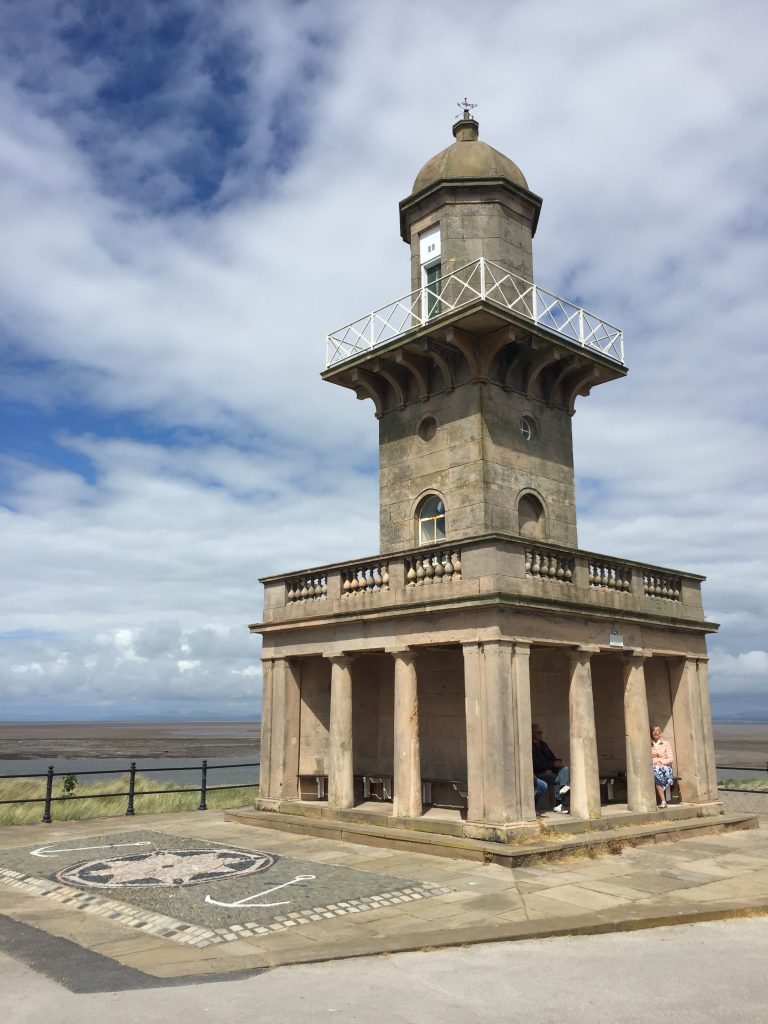I’d made no plans for my birthday, zero, zilch, nada. I opened the curtains. Heavy rain was streaming down the windows and low water-laden clouds obscured the hills above me. “What did you do for your birthday?” Ironing,? Vacuuming? Grocery shopping? Hmmm . . . think . . .. think . . . And then I recalled that I’d been thinking about going to Blackpool. A friend had recently gone for a day trip to that seaside town, and I’d been meaning to go there for the last 4 years. It’s easy since it’s just one through train. I looked up the weather forecast for Blackpool. Lo and behold: A full day of sun. A no brainer. And off I ran through the pouring rain to the station for the next train to Blackpool.

It takes an hour and 20 minutes and goes through the lovely countryside of the Cliviger valley, the brilliant green of the hills dotted with lambs. By the time we had reached Preston it had a least stopped raining. Preston station reminded me of trips to see my mother-in-law who had lived in Preston when I knew her. By the time I reached Blackpool at 11 a.m. the sun was shining brightly and a predominantly blue sky had the occasional fluffy white cloud scudding across its vast expanse.
I arrived at Blackpool North and within 10 minutes I’d found my way to the sea front and the North Pier.

There was not a single person on the beach, or in the wind shelters on the promenade. I didn’t see one piece of litter on ‘the front’ though the streets inland have seen better days with many shops shut down between the rows of bed and breakfast houses.

The last time I’d been to Manchester was in 1996 on a trip from the U.S. I looked up my holiday journal. We’d driven over to Blackpool from Preston on our first evening after flying out from San Francisco.

Since I was just by the north pier I decided to walk its length, the longest of the three coastal piers seeing lovely examples of Victorian wrought ironwork. A placard on the pier told of its history and construction. It was constructed in the 1860s and the architect was . . . .Claude Debussy!!! What? The photograph on the sign was of Debussy, the French composer. The name of the architect was Eugenius Birch! I couldn’t believe what I was seeing. I’d done my undergraduate dissertation on Debussy and the Impressionist movement and I knew this photo of Debussy well. I would follow up this when I got home.

It was windy but still beautifully sunny. There were very few people walking on the pier, a few cafes and tourist gift shops were open.

Seeing the tower reminded me of visiting the Temple Bar and Grill under the tower. My dad’s mum used to take us there occasionally for a special treat. I remember going down a little alleyway to a brick building in which was a small restaurant. Eating out was a complete rarity so that’s why it sticks in my mind. I don’t recall how we got there because my dad didn’t get a car until I was about 10 years old. I called in at the tourist information centre on the front to ask about it. The man had heard of it but believed it had been an Irish bar, named after Temple Bar in Dublin, a district that I’d visited a couple of years ago. That didn’t seem to fit my memory so I set off to see if I could find it.

I found Temple Street behind the tower. A narrow alley, just as I’d remembered it. It now just has a tapas place on the corner and further down, where I though the grill should be is an electricity substation. But what this? A plaque on the wall.

This plaque would explain why how the grill got its name so I’m pretty sure that this was the location of my family’s meals – and had nothing to do with Dublin!
How about a ride to the top of the tower? I had seen the lift going up and down from the pier and since this was my birthday that would be a memorable way to celebrate.

The tower has 7 floors of venues, restaurants, bars, gift shops. I found the sign posting sadly lacking. I mean, just trying to find my way to the toilet was a major undertaking. However, having refreshed with a coffee in one of the cafes with wonderful views overlooking the sea, I found my way to the lift and up we went with a real person operating it!
http://blog.hmcreativelady.com/wp-content/uploads/2022/05/IMG_7304.mov
The glass viewing platform extended beyond the tower itself and though other people seemed quite happy to stand on it and pose for photos I couldn’t bring myself to do that. It reminded me on the big shopping centre in Paris where Anna was quite happy to walk onto the platform but I just couldn’t. But the views today were wonderful, both out to the sea and inland to the town itself.


The man in the tourist information centre had mentioned the market at Fleetwood so I decided to take the tram along the waterfront to Fleetwood. My dad used to go on fishing trips to Fleetwood and Heysham when I was a little girl – sleeping in the car. It was fun to go for a tram ride. It took 45 minutes and it was STILL sunny when I reached my destination. A large hotel dominated this stretch of coast and in the adjacent garden was an imposing statue. He appeared to be holding a lighthouse. The man was Peter Hesketh-Fleetwood. Fleetwood acquired its modern character in the 1830s, when he, the High Sheriff and MP, conceived an ambitious plan to re-develop the town to make it a busy seaport and railway spur. He commissioned the distinguished Victorian architect Decimus Burton to design a number of substantial civic buildings, including two lighthouses. Hesketh-Fleetwood’s transport terminus schemes failed to materialise. The town expanded greatly in the first half of the 20th century with the growth of the fishing industry, and passenger ferries to the Isle of Mann to become a deep-sea fishing port. Wow! I never knew that the town of Fleetwood was named after a person.



The beach was fenced off with Danger signs warning of dangerous tides, but there was lots of colour in the grasses and flowers.


After battling with the wind for half an hour on the beach I headed off towards the market to find some lunch.


Although market rights were granted to Fleetwood Market in 1725, it wasn’t until 1840 when Sir Peter Hesketh-Fleetwood started using those rights that the Victorian Market was built. The building has stayed true to its Victorian heritage and has changed very little. However, in 1990 the market was extended, and as a result is one of the largest markets in North West of England. It has over 150 stalls within three indoor heated halls and a selection of outdoor stalls. I think I’ll come back to spend more time at the market. I came home with a long white cardigan – a birthday present to myself.

As I headed to find the tram back to Blackpool I saw an interesting shop front on the Esplanade. Not far away was an old tram stop. I wondered if it would stop at this preserved tram stop but I found one looking more up – to-date.

Back on the tram we passed a vey grand looking building which turned out to be the Rossall School which educates girls and boys aged 0-18 as both a day school and a boarding school. Amazingly it boasts that it’s an All Steinway school and has its own piano academy. Fee are up to 12,000 per term for a boarder and to belong to the piano academy is just a further 4,800 per year! The main building looks very much Bolton School, my old secondary school. One of the school’s most famous alumni was Sir Thomas Beecham who founded the London Philharmonic and the Royal Philharmonic orchestras. He was also closely associated with the Liverpool Philharmonic and Hallé orchestras. From the early 20th century until his death, Beecham was a major influence on the musical life of Britain and, according to the BBC, was Britain’s first international conductor. Ah, that’s why there’s a music academy at Rossall. Rossall is a school steeped in history, and is, according to the school’s website often referred to as ‘The Eton of the North’.
The school was founded in 1844 by Rev. St Vincent Beechey as a sister school to Marlborough College which had been founded the previous year. Its establishment was ‘to provide, at a moderate cost, for the sons of Clergymen and others, a classical, mathematical and general education of the highest class.’
Beechey set about finding the funds required to set up such a school and received support from many including The Earl of Derby, the Duke of Devonshire and the Bishop of Chester. Sir Peter Hesketh Fleetwood agreed to lease his ancestral home of Rossall Hall to the school on a 21 year lease with the option to purchase for £7000 in the first ten years. The Northern Church of England Boarding School, renamed Rossall College under the reign of its first Headmaster Dr John Woolley, opened on 22 August 1844 with 70 boys enrolled. By the following March 120 pupils were in residence. Rossall was part of a flurry of expansion in education during the early Victorian period and the School was granted a Royal Charter on 21 October 1890. Rossall was widely considered to be in the top 30 public schools in the UK and by the end of Queen Victoria’s reign its academic results were among the best in the country and enjoyed a reputation as ‘The Eton of the North’. Girls first joined the school in the 1970’s and currently represent half of the student body.

Arriving back in Blackpool there was a long queue of people outside the railway station. I though they were waiting for taxis but I was soon informed that an accident had occurred on the train line in Blackpool and no trains could use the station. I joined the queue, waiting for half an hour for the replacement bus service that took us back to Preston station, taking an hour in the heavy rush hour traffic but at least I saw some new scenery. Luckily the train back to Hebden arrived a few minutes after I did and I arrived home at 7, just in time to guzzle down some dinner whilst chatting to my daughters before my weekly zoomed pub quiz.
After the quiz I looked up the Blackpool Debussy connection. Sure enough I’m correct. Not only is the photograph of North pier’s architect really Debussy but whoever designed the placard about the architect has used the Wikipedia photo of Debussy. So far I have left three messages with the company that operate the North pier but they haven’t returned my calls!









I remembered I had seen Debussy on the north pier, googled Claude Debussy Blackpool and ended up on this post.
This was beautiful! I enjoyed reading it lots, I loved the pictures, and I sure hope they remove Debussy’s picture from there. But to be honest, a part of me still wants him there, it’s a nice oddity in Blackpool which will forever make me smile.
Blackpool is still one of my favorite places to visit in the UK, and your post captures the reasons why!